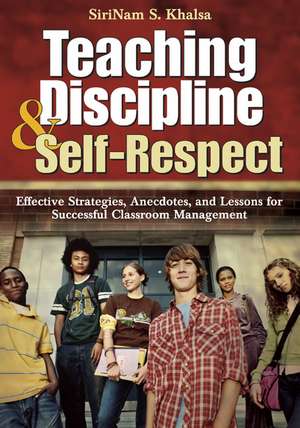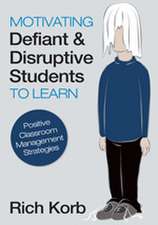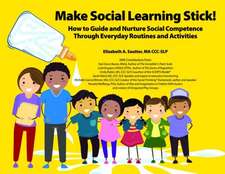Teaching Discipline & Self-Respect: Effective Strategies, Anecdotes, and Lessons for Successful Classroom Management
Autor SiriNam S. Khalsaen Limba Engleză Paperback – 4 apr 2007
| Toate formatele și edițiile | Preț | Express |
|---|---|---|
| Paperback (1) | 296.89 lei 6-8 săpt. | |
| SAGE Publications – 4 apr 2007 | 296.89 lei 6-8 săpt. | |
| Hardback (1) | 535.31 lei 6-8 săpt. | |
| SAGE Publications – 4 apr 2007 | 535.31 lei 6-8 săpt. |
Preț: 296.89 lei
Nou
Puncte Express: 445
Preț estimativ în valută:
56.84€ • 58.45$ • 47.15£
56.84€ • 58.45$ • 47.15£
Carte tipărită la comandă
Livrare economică 19 februarie-05 martie
Preluare comenzi: 021 569.72.76
Specificații
ISBN-13: 9781412915489
ISBN-10: 1412915481
Pagini: 200
Dimensiuni: 178 x 254 x 12 mm
Greutate: 0.43 kg
Ediția:1
Editura: SAGE Publications
Colecția Corwin
Locul publicării:Thousand Oaks, United States
ISBN-10: 1412915481
Pagini: 200
Dimensiuni: 178 x 254 x 12 mm
Greutate: 0.43 kg
Ediția:1
Editura: SAGE Publications
Colecția Corwin
Locul publicării:Thousand Oaks, United States
Recenzii
"Clear advice for new teachers struggling to develop a system and build rapport with students. Offers valuable insight into certain types of behaviors for any educator looking for a ‘new way’ to handle discipline problems."
"Refreshingly positive. Provides tangible, doable techniques and describes respectful, sensitive approaches that can be implemented by all teachers with all students."
"Packs in lesson plans, strategies, and anecdotes from successful classroom management projects and thus is a top pick for teachers who wish to receive the applied experience of other professionals."
“Khalsa does not propose a ‘one size fits all’ or single system approach to classroom management, as is typical in classroom management books. Rather the focus is on a realistic classroom management approach based on the myriad of human characteristics displayed by the diverse students in today’s classrooms.”
"Refreshingly positive. Provides tangible, doable techniques and describes respectful, sensitive approaches that can be implemented by all teachers with all students."
"Packs in lesson plans, strategies, and anecdotes from successful classroom management projects and thus is a top pick for teachers who wish to receive the applied experience of other professionals."
“Khalsa does not propose a ‘one size fits all’ or single system approach to classroom management, as is typical in classroom management books. Rather the focus is on a realistic classroom management approach based on the myriad of human characteristics displayed by the diverse students in today’s classrooms.”
Cuprins
Foreword by Jeffrey R. Ryan
Acknowledgments
About the Author
Introduction: About This Book
The Boatman and the Passenger
What Is Teaching Discipline and Self-Respect?
Outcomes of Teaching Discipline and Self-Respect
Chapter Organization
1. Building Cooperation and a Community of Learners
The Heart of an Eagle
Rapport: The Power of Relationships
Outcomes of Establishing Rapport
How to Develop Rapport
Techniques for Creating Dialogue
Strategies for Creating Cooperation
Building a Community of Learners
2. Creating Classroom Procedures and Routines
Changing Behavior Cycles
Discipline Versus Punishment
Alternatives to Punishment
Classroom Procedures and Routines
Teaching Classroom Procedures and Routines
Steps for Teaching Procedures and Routines
Thinking Signs
Follow-Up Feedback
3. Teaching Discipline and Self-Respect
Who's in Charge? Establishing Authority
Promoting Desirable Behavior
Promoting Desirable Behavior Outside the Classroom
Inviting Cooperation
Scenarios for Creating Cooperation in the Classroom
Offering Choices--Within Limits
Academic Choice
Avoiding Power Struggles
Setting Limits Through Thinking Words
The Criticism Trap
4. Strategies Impacting Positive Discipline and Self-Respect
Time Out
Repeating
Redirecting
Momentum
Self-Monitoring Checklist
Self-Control Cards
Staying in the Present
Collaborative Teaming: Many Heads Are Better Than One
5. Changing Eleven Negative Behavior Cycles
1. The Class Bully
2. The Class Clown
3. The Interrupter
4. The Disorganized Student
5. The Overly Sensitive Student
6. The Teaser
7. The Property Destroyer
8. The Fighter
9. The Student Who Feels Stupid
10. The Nervous Student
11. The Student Who Makes Sexual Overtones
6. Understanding Diverse Students and Difficult Circumstances
Working With Students and Families Who Are Disadvantaged
Scenarios for Responding to Events: Internal Voices
Understanding Culture and Linguistic Differences
ADHD: A Mistaken Disorder
Enhancing the Potential of All Students
7. Managing Your Stress: Help for Educators
Avoiding Burnout
Maintaining a Positive Mental Attitude: 15 Steps
Releasing Stress
Concluding Thoughts
References
Index
Acknowledgments
About the Author
Introduction: About This Book
The Boatman and the Passenger
What Is Teaching Discipline and Self-Respect?
Outcomes of Teaching Discipline and Self-Respect
Chapter Organization
1. Building Cooperation and a Community of Learners
The Heart of an Eagle
Rapport: The Power of Relationships
Outcomes of Establishing Rapport
How to Develop Rapport
Techniques for Creating Dialogue
Strategies for Creating Cooperation
Building a Community of Learners
2. Creating Classroom Procedures and Routines
Changing Behavior Cycles
Discipline Versus Punishment
Alternatives to Punishment
Classroom Procedures and Routines
Teaching Classroom Procedures and Routines
Steps for Teaching Procedures and Routines
Thinking Signs
Follow-Up Feedback
3. Teaching Discipline and Self-Respect
Who's in Charge? Establishing Authority
Promoting Desirable Behavior
Promoting Desirable Behavior Outside the Classroom
Inviting Cooperation
Scenarios for Creating Cooperation in the Classroom
Offering Choices--Within Limits
Academic Choice
Avoiding Power Struggles
Setting Limits Through Thinking Words
The Criticism Trap
4. Strategies Impacting Positive Discipline and Self-Respect
Time Out
Repeating
Redirecting
Momentum
Self-Monitoring Checklist
Self-Control Cards
Staying in the Present
Collaborative Teaming: Many Heads Are Better Than One
5. Changing Eleven Negative Behavior Cycles
1. The Class Bully
2. The Class Clown
3. The Interrupter
4. The Disorganized Student
5. The Overly Sensitive Student
6. The Teaser
7. The Property Destroyer
8. The Fighter
9. The Student Who Feels Stupid
10. The Nervous Student
11. The Student Who Makes Sexual Overtones
6. Understanding Diverse Students and Difficult Circumstances
Working With Students and Families Who Are Disadvantaged
Scenarios for Responding to Events: Internal Voices
Understanding Culture and Linguistic Differences
ADHD: A Mistaken Disorder
Enhancing the Potential of All Students
7. Managing Your Stress: Help for Educators
Avoiding Burnout
Maintaining a Positive Mental Attitude: 15 Steps
Releasing Stress
Concluding Thoughts
References
Index
Descriere
Used successfully in culturally, economically, and academically diverse classrooms, these strategies and activities focus on developing students' self-esteem, self-image, and self-responsibility.














